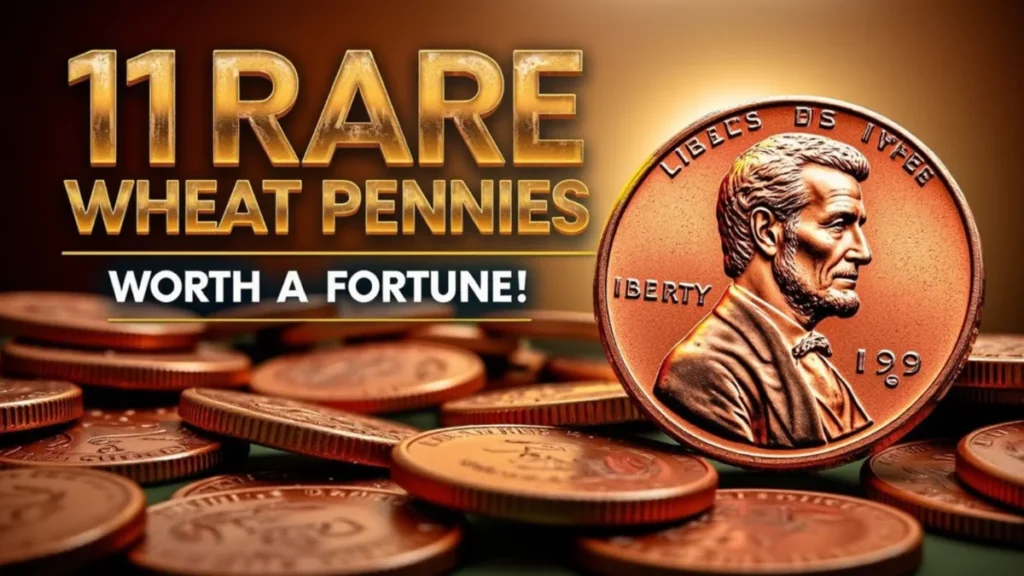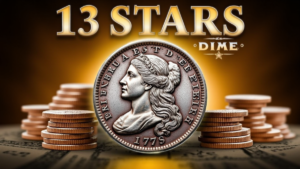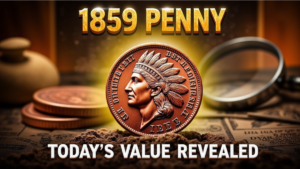Wheat pennies, minted between 1909 and 1958, are known for their iconic design featuring two ears of wheat on the reverse. While many Wheat pennies hold sentimental value, some can be worth a fortune—especially error coins, which were minted due to mistakes at the U.S. Mint.
These errors are highly collectible and often command impressive prices at auction. Let’s look into the most valuable Wheat penny errors you should look out for.
Table of Contents
1 1943 Double Die Obverse
2 1943 (D) Repunched Mintmark
3 1944 D/S Mintmark Error
4 1936 Double Die Obverse
5 1909 S Over Horizontal S
6 1917 Double Die Obverse
7 1922 No D
8 1955 Double Die Obverse
9 1958 Double Die Obverse
10 1943 Bronze Cent
11 1943 Experimental Shell Case Cent
12 FAQs
1943 Double Die Obverse

A double die obverse (DDO) error occurs when the die used to strike the coin shifts slightly between impressions, creating a doubled image. The 1943 DDO Wheat penny is one of the most prominent examples, with clear doubling on the letters in LIBERTY and the 9 and 3 in the date.
Low-grade circulated coins: $30
AU55 (About Uncirculated): $100
MS65 (Mint State): $1,500
1943 (D) Repunched Mintmark
Repunched mintmarks (RPM) occur when the mintmark is struck more than once, resulting in a doubled appearance. The 1943-D Wheat penny has an RPM where the first “D” appears slightly below and left of the stronger mintmark.
Fine (F12): $75
Uncirculated: $200
Best mint state examples: $1,000 to $15,000
1944 D/S Mintmark Error

This fascinating error occurred when a Denver die with an S mintmark from San Francisco was repunched with a D mintmark. The original “S” is faintly visible beneath the “D.”
Fine condition: $75
About uncirculated: $260
Mint State: $4,000 to $20,000
1936 Double Die Obverse
The 1936 Wheat penny from Philadelphia features noticeable doubling on the words IN GOD WE TRUST and LIBERTY. Even the numbers in the date show clear signs of doubling.
Circulated examples: $100
AU55 (Almost Uncirculated): $200
MS65: $600
Top-grade examples: $5,000
1909 S Over Horizontal S
The 1909 S over horizontal S is a rare mintmark error where the original “S” mintmark was punched at a horizontal angle before being corrected. This subtle error requires a close inspection.
Circulated coins: $100
Uncirculated examples: $250
MS67 (Red Penny): $32,900
1917 Double Die Obverse
The 1917 Wheat penny from Philadelphia is another example of a double die obverse error. The doubling is most evident in IN GOD WE TRUST and the date.
Circulated examples: $200
Almost Uncirculated: $1,500
Mint State (MS60): $3,750
Best-known red penny (MS67+): $135,000
1922 No D

The 1922 No D Wheat penny is an iconic error coin. Despite lacking a mintmark, it was actually struck at the Denver Mint. This error occurred when the die was overpolished, removing the mintmark.
XF45 (Extremely Fine): $500
AU55 (Brown Coin): $6,350
MS65 (Mint State): $90,000
Top Red Coin (MS64): $275,000
1955 Double Die Obverse
The 1955 DDO is one of the most famous and valuable error coins. The doubling on this penny is so dramatic that it’s visible without magnification.
Circulated examples: $1,200
AU55 (Brown): $2,650
MS65+ (Red Penny): $288,000
1958 Double Die Obverse
With only three known examples, the 1958 double die obverse is one of the rarest and most valuable Lincoln pennies ever found. The doubling is sharp and clear on IN GOD WE TRUST and LIBERTY.
MS64 (Two known examples): $340,000
MS65 (Single known example): $1.14 million
1943 Bronze Cent
Most 1943 pennies were struck on steel planchets due to a copper shortage during World War II. However, a few were mistakenly struck on leftover bronze planchets from 1942.
XF45 (Brown Coin): $215,000
MS63 (Red Coin): $1 million
1943 Experimental Shell Case Cent
In 1943, some experimental cents were made from a copper, zinc, and silver alloy. These coins were trial pieces and are extremely rare.
Estimated value: $150,000
Wheat penny errors are some of the most exciting finds for collectors. With values ranging from a few hundred dollars to over a million, these coins are worth checking for in your collection. Who knows—you might just discover a hidden treasure!
FAQs
1.What are Wheat Penny error coins?
Wheat Penny error coins are pennies minted between 1909 and 1958 with flaws or mistakes during the production process. These flaws can range from misprints, doubled dies, to off-center strikes, making them highly valuable to collectors.
2.Why are Wheat Penny error coins so valuable?
Wheat Penny error coins are valuable because they are rare, especially when the error is unique or extremely difficult to find. Collectors are drawn to these coins due to their scarcity, historical significance, and the intriguing story behind the mistakes made during their minting process.
3.How can I identify a valuable Wheat Penny error coin?
To identify a valuable Wheat Penny error coin, look for common errors such as double dies, misaligned strikes, off-center strikes, or unusual mint marks. Having the coin evaluated by a professional numismatist or using a detailed error coin guide can help confirm its value.
4.What are the most sought-after Wheat Penny error coins?
Some of the most sought-after Wheat Penny error coins include the 1943 copper Wheat Penny, 1955 double die obverse, and the 1944 steel penny. These coins are rare due to their minting mistakes, making them highly prized by collectors.
5.How do I sell my Wheat Penny error coins?
If you have a valuable Wheat Penny error coin, you can sell it through online auction platforms, coin dealers, or at numismatic conventions. To ensure you get the best price, have the coin professionally appraised and graded by a reputable service.


